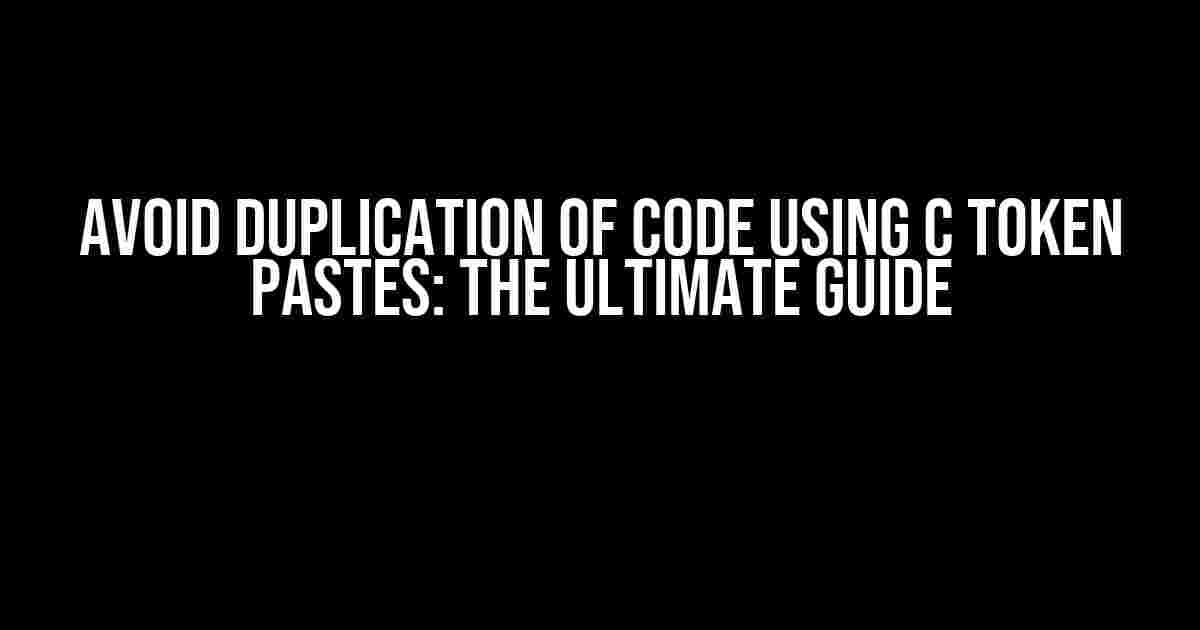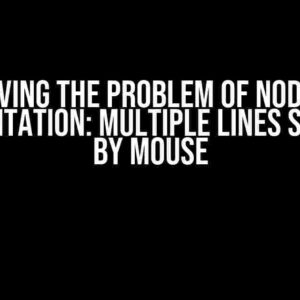As a programmer, you’ve probably found yourself in situations where you need to write the same code multiple times, with minor changes each time. This is not only tedious but also prone to errors. What if I told you there’s a way to avoid duplication of code using C token pasters? In this article, we’ll explore the wonders of token pasting and how it can revolutionize your coding experience.
What are C Token Pastes?
Token pasting, also known as token concatenation, is a feature in the C programming language that allows you to combine multiple tokens into a single token. A token is the basic building block of a C program, such as keywords, identifiers, constants, and symbols. By pasting tokens together, you can create new tokens that can be used in your code. Sounds confusing? Don’t worry, it’s simpler than it sounds!
#define PASTE(a, b) a##b
#define XPASTE(a, b) PASTE(a, b)
int XPASTE(my, var) = 10;
In the above example, the `XPASTE` macro paste the tokens `my` and `var` together to form the single token `myvar`. This is a simple example, but it demonstrates the power of token pasting.
Why Avoid Duplication of Code?
Duplicating code is a common phenomenon in programming, but it’s also a recipe for disaster. Here are some reasons why you should avoid duplication of code:
- Maintenance Nightmare: When you duplicate code, you need to maintain multiple copies of the same code. This can lead to inconsistencies and errors.
- Bugs Galore: When you fix a bug in one copy of the code, you need to remember to fix it in all other copies. This can be a daunting task, especially in large codebases.
- Code Bloat: Duplicate code can lead to code bloat, making your program larger than necessary.
- Tight Coupling: Duplicate code can create tight coupling between different parts of your program, making it harder to modify or replace individual components.
How to Avoid Duplication of Code using C Token Pastes
Now that we’ve covered the importance of avoiding duplication of code, let’s dive into how you can use C token pastes to achieve this goal. Here are some scenarios where token pasting can help:
Scenario 1: Function Macros
Imagine you need to write a set of functions that perform similar tasks, but with slight variations. Instead of duplicating code, you can use token pasting to create a single function macro that can be reused.
#define FUNC(name, type) \
type func_##name##_##type(type x) { \
/* function body */ \
return x * 2; \
}
FUNC(add, int)
FUNC(mul, float)
FUNC(div, double)
In this example, the `FUNC` macro creates three separate functions: `func_add_int`, `func_mul_float`, and `func_div_double`. Each function performs a different operation, but the code is generated using a single macro.
Scenario 2: Constants and Enumerations
When working with constants and enumerations, you often need to define multiple values with similar names. Token pasting can help you simplify this process.
#define COLOR(r, g, b) color_##r##_##g##_##b
enum colors {
COLOR(red, green, blue),
COLOR(green, blue, red),
COLOR(blue, red, green)
};
In this example, the `COLOR` macro generates three separate enumeration values: `color_red_green_blue`, `color_green_blue_red`, and `color_blue_red_green`. This eliminates the need to write duplicate code for each enumeration value.
Scenario 3: Error Handling
Error handling is an essential part of programming, but it can be tedious to write the same error-handling code multiple times. Token pasting can help you simplify this process.
#define HANDLE_ERROR(code, err) \
void handle_##code##_error_##err() { \
/* error handling code */ \
printf("Error %d occurred\n", err); \
}
HANDLE_ERROR(io, 1)
HANDLE_ERROR(net, 2)
HANDLE_ERROR(db, 3)
In this example, the `HANDLE_ERROR` macro generates three separate functions: `handle_io_error_1`, `handle_net_error_2`, and `handle_db_error_3`. Each function handles a different type of error, but the code is generated using a single macro.
Best Practices for Using C Token Pastes
While token pasting can be a powerful tool, it’s essential to use it judiciously. Here are some best practices to keep in mind:
- Keep it Simple**: Token pasting can get complex quickly. Keep your macros simple and focused on a specific task.
- Use Meaningful Names**: Choose meaningful names for your macros and tokens to avoid confusion.
- Document Your Macros**: Document your macros and token pasting usage to help others understand your code.
- Avoid Overuse**: Don’t overuse token pasting. It’s meant to simplify your code, not make it more complicated.
- Test Thoroughly**: Test your token-pasted code thoroughly to ensure it works as expected.
Conclusion
Avoiding duplication of code using C token pastes is a powerful technique that can simplify your programming experience. By mastering token pasting, you can write more efficient, maintainable, and error-free code. Remember to use token pasting judiciously and follow best practices to get the most out of this powerful feature.
| Token Pasting Scenario | Description |
|---|---|
| Function Macros | Create reusable function macros to avoid duplication of code. |
| Constants and Enumerations | Simplify the definition of constants and enumerations using token pasting. |
| Error Handling | Use token pasting to generate error-handling code that’s efficient and easy to maintain. |
By applying these techniques and best practices, you’ll be well on your way to becoming a token-pasting master. Happy coding!
Frequently Asked Question
Get ready to unlock the secrets of avoiding code duplication using C token pasters!
What is the primary purpose of using C token pasters?
C token pasters are used to avoid code duplication by allowing developers to generate code snippets that can be reused throughout their program. This not only saves time but also reduces the risk of errors and maintenance headaches.
How do C token pasters differ from traditional copy-paste methods?
Unlike traditional copy-paste methods, C token pasters use a template-based approach to generate code snippets. This allows for more flexibility and adaptability, as the generated code can be easily customized to fit specific needs. Plus, token pasters reduce the risk of introducing errors or inconsistencies into your codebase.
What kind of code duplication can C token pasters help eliminate?
C token pasters are particularly useful for eliminating duplication of boilerplate code, such as function prototypes, error handling, and logging mechanisms. By generating these code snippets automatically, developers can focus on writing more critical logic and features.
Are C token pasters limited to C programming language only?
No way! While the name “C token pasters” might suggest otherwise, these tools can be used with various programming languages, including C++, Java, Python, and more. The concept of token pasting is language-agnostic, making it a valuable asset for developers across the board.
How do I get started with using C token pasters in my projects?
To get started, you’ll need to choose a token pasting tool that fits your needs. Research popular options, such as M4, Cog, or GPP, and explore their documentation and tutorials. Once you’re comfortable with the basics, start by identifying areas in your codebase where token pasters can help eliminate duplication, and then integrate them into your workflow.




